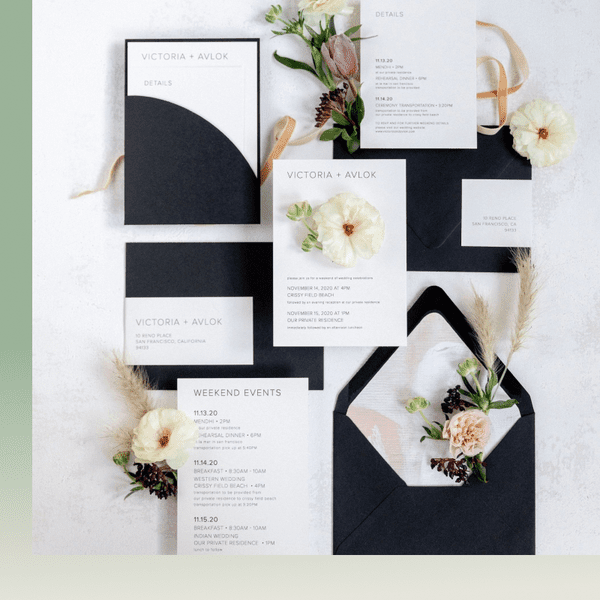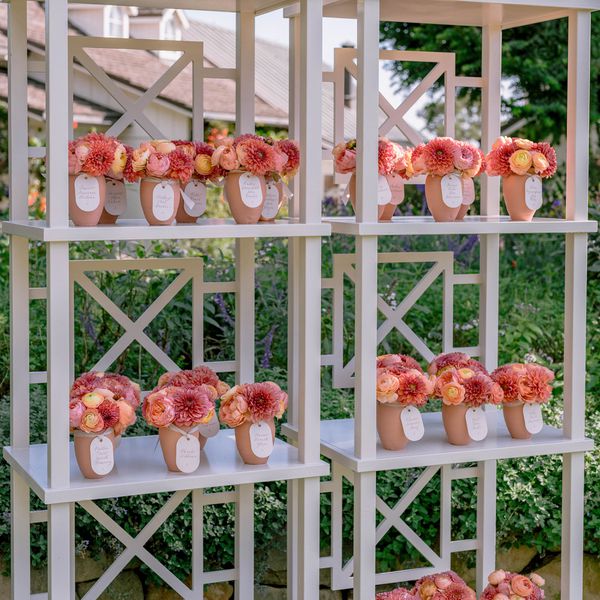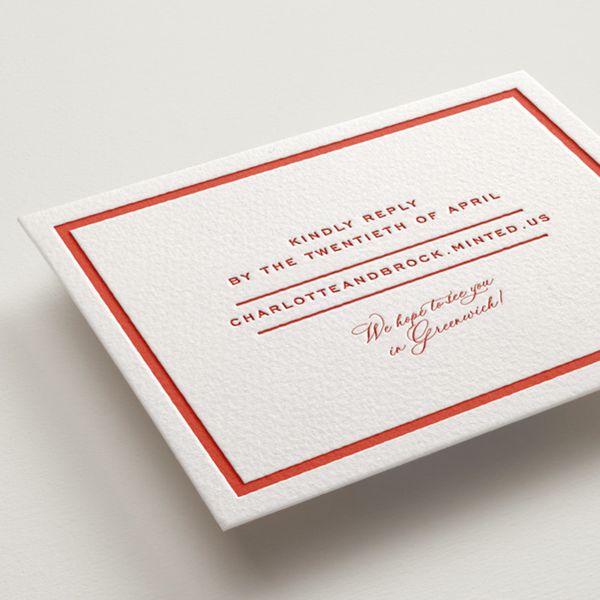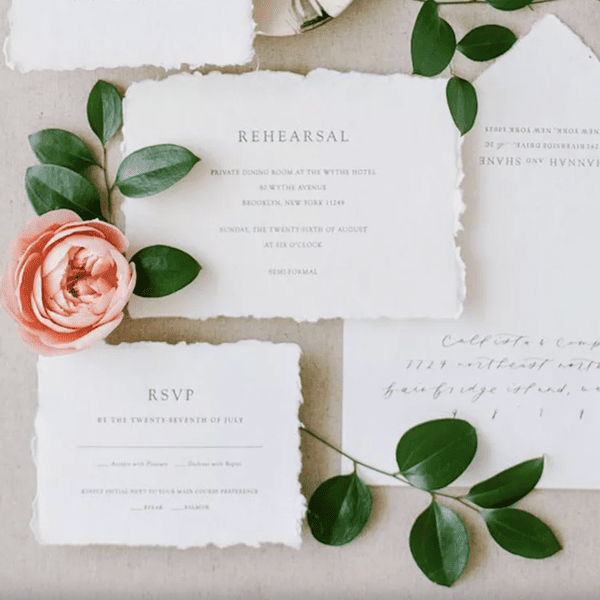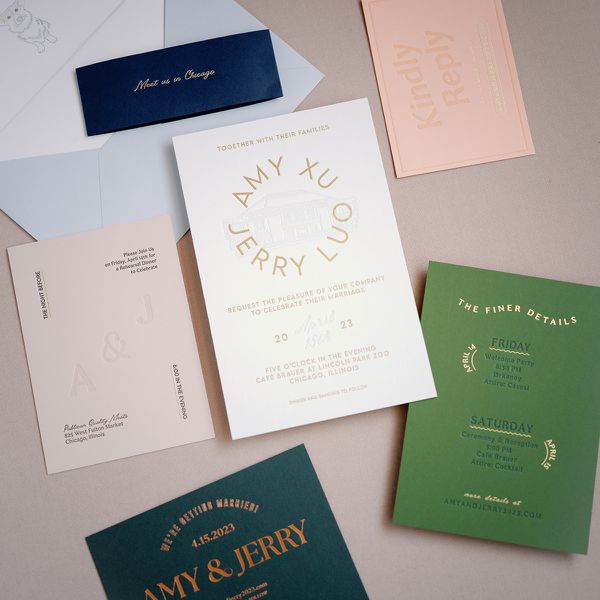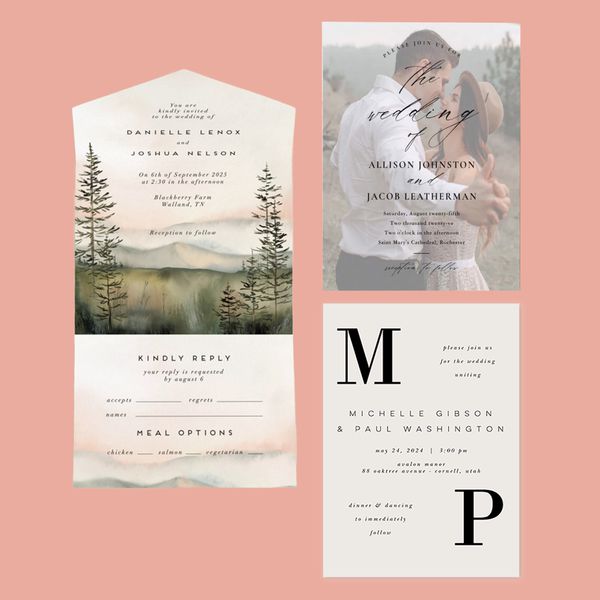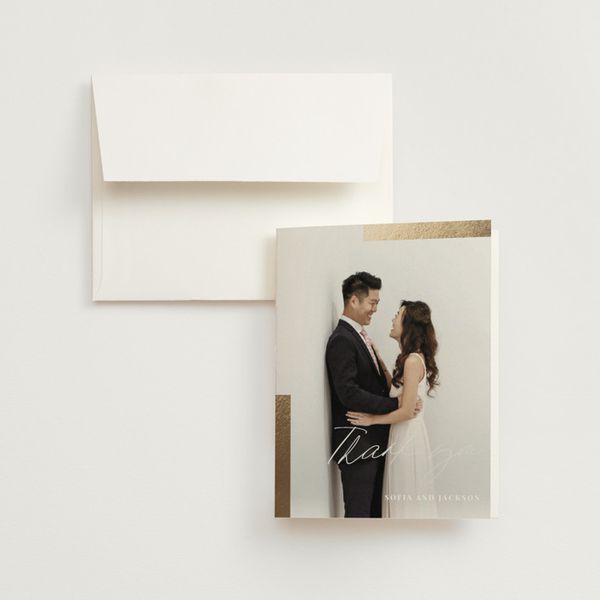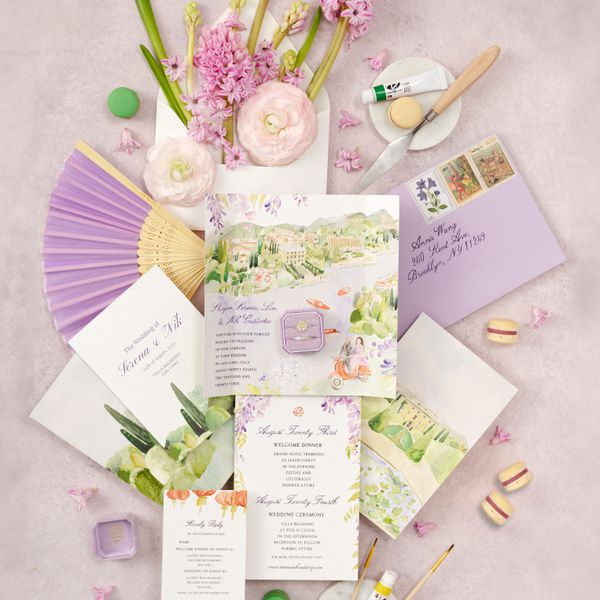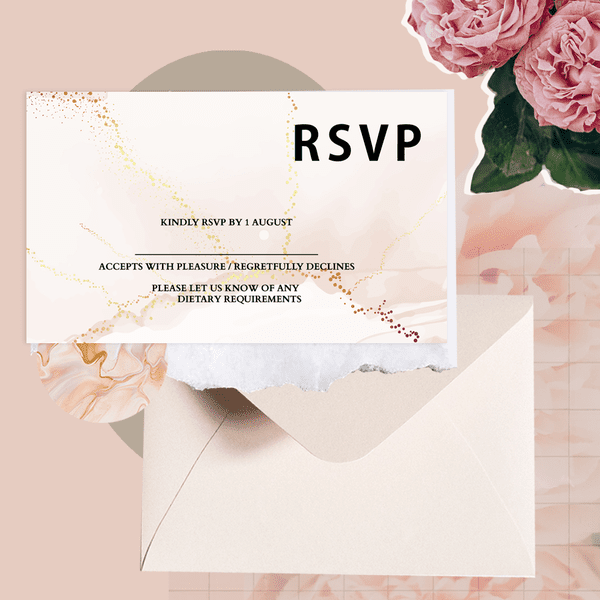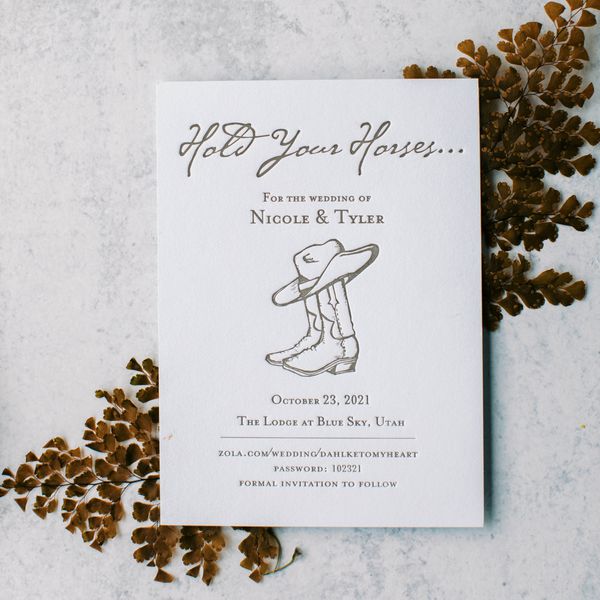:max_bytes(150000):strip_icc()/wedding-details-card-kristin-la-voie-recirc-0424-d719386fe04d4f2ba448aab3eb55bce2.jpg)
Photo by Kristin La Voie Photography
While the central invitation card is the most important piece of your paper suite, telling your guests when and where you’re holding your ceremony, it’s the details card that can take your stationery set from just beautiful to helpful and informative for guests. These cards (most suites include more than one!) are must-haves for your attendees, since they share need-to-know information about times, locations, attire, and contact information, as well as for couples (you definitely want those RSVP cards included!). They are also a prime opportunity to up the design ante of your big-day paper; a details card can complements a keepsake invitation with colorful shapes, custom accents, and previews of your overall aesthetic.
Meet the Expert
- Kelly McWilliams is a wedding planner and event designer based in southwest Florida. She has been in the industry for over 20 years.
- Jill Eitelberg is the owner and creative lead at The Dandelion Patch, a stationery business.
At the heart, though, these additional notes are the workhorses of your paper suite. “The detail cards make being a guest easier,” says event planner Kelly McWilliams. “It’s what makes them the most at ease about attending your event—and they also provide the opportunity to make them even more excited.” Ahead, McWilliams and stationer Jill Eitelberg, the owner and creative lead at The Dandelion Patch, explain everything you need to include on a wedding details card and how to design yours—plus several examples from real weddings to inspire how your own wedding details card comes together.
What Is a Wedding Details Card?
The main element in your invitation suite is the invitation itself: the card listing the date, time, formality level, and location of your ceremony. “Your invitation card should be the most special part of your wedding stationery suite. It is meant to acknowledge you and your fiancé’s impending nuptials and to honor the hosts of the event (most often parents),” says McWilliams. “Nothing else should distract from these details.”
That's where a wedding details card comes in: You can cover all other need-to-know intel on this separate note, so your main invitation can shine. This card (or cards) provides guests with other helpful information—like the reception location (if it’s different from your ceremony venue), your wedding website, your dress code (if it's more detailed, you should explain!), and the hotel block reservation process. The RSVP card that guests return to you is also technically a wedding details card and should be included in this part of your invitation suite.
What to Include on a Wedding Details Card
Key Takeaways
- You can use your wedding details card to communicate need-to-know information to your guests without overcrowding your main invitation.
- You can include more than one wedding details card in your invitation suite; if you're throwing a destination wedding or a multi-event celebration, you will likely need a few.
- You'll want to include hotel, travel, wedding website, dress code, and itinerary information on your wedding details cards, among other things.
Not every couple will need more than one wedding details card—but many duos opt for several to make information a little more digestible for guests. “If you’re having a wedding in the town that you live in and the majority of your guests aren’t traveling, then your details card may only [list] reception time and address, attire, and mention of a wedding website,” says McWilliams. “The best way to consider what cards you’ll need is to list out everything that you think your guests need to know in advance of your wedding. From there, you can decide which cards are necessary.”
The following details, like dress code and wedding website information, can be included on one wedding details card or spread across several; it's up to you. Whether you opt for one or three, the below information, should, however, appear somewhere on these cards.
RSVP Information
Even the most minimalist suite needs to include a way for guests to RSVP—and the date by which they should do so (McWilliams recommends setting an RSVP deadline of 45 days before your wedding). The traditional response card should include spaces for guests’ names, whether they are accepting or declining your invitation, and a meal selection (if applicable) and dietary restrictions. Some couples also use this card to tally responses for other wedding weekend events—like the welcome party or day-after brunch. “If you are trying to plan transportation for events, also consider asking for their accommodations,” says McWilliams.
If you prefer to track your responses digitally, include a QR code that links guests to a Google form or the RSVP tracker on your wedding website, where you can request other details that add to your guests’ experience. “Want to make it fun? Add a line asking, ‘What song will get you on the dance floor?’”says McWilliams. “Send the list over to your band or DJ and ask them to include some of the more popular on the playlist for the evening.”
Wedding Weekend Details
“If you are hosting a wedding weekend, you’ll want to consider including a weekend card that lists the events with their time, location, attire, and if transportation is provided,” says McWilliams. “If you’re hosting any adults-only events, consider listing a website or phone number for a babysitting service to drive the point home.”
Hotel Details
Whether you’re planning a far-flung destination wedding or booked a room block for your out-of-town college friends, a hotel or accommodations card makes travel plans easier for your guests. “An accommodation card should offer the name of the hotel(s) with their phone numbers, websites and the name or code that the hotel requires for the room block,” says McWilliams. “Also offer the cut-off date and, if you have enough room, the distance from the hotel to your events.”
Travel Details
For weddings with a majority of guests making travel plans, you can include a separate card with information on nearby airports, shuttles, and car rental options. “If Uber isn’t widely available, make this clear and offer a phone number for a local taxi or car service,” says McWilliams. You can share other local information on this card, too, like a favorite coffee shop, a must-see hiking trail, or a nearby museum.
Maps
Most of your guests will use their go-to trip planning app to navigate between your wedding weekend events—but a map card can still be a pretty, practical addition to your invite suite. “You can use them to notate where your events are around town, including hotels and airports,” says McWilliams. “If you’re creating a map for fun, consider one with famous landmarks or places that are meaningful to you and your fiancé.”
Itineraries
Guests are more likely to reference a digital itinerary from their phones during your wedding weekend than they are to carry a paper copy, says McWilliams, but including this card in your invitation suite is a fun way to preview the details. List all the pertinent information for each event: times, locations, dress codes, transportation options.
Dress Code
Speaking of dress codes—whether you're hosting black-tie affair in New York City or a shoes-optional casual soirée on the beach this summer, you should clearly communicate the formality level of your wedding on your details card. If you've gone the extra mile and created a Pinterest moodboard for guests, consider including a QR code that drives attendees straight to it.
Wedding Website
Your wedding website address doesn’t belong on your formal invitation, but you can include it on other details cards, like the accommodations or itinerary cards, or include a single card with the URL or a QR code. Add this alongside your other details cards—or instead of them. “A website card is great if you want to save on costs and paper!” says McWilliams.
Leave the direct link to your wedding registry off your wedding details card. Instead, make sure it is accessible via your wedding website and drive guests there, instead.
New Address
While fewer couples wait until after their wedding to move in together, this card is a formal nod to tradition. “It’s becoming more and more rare, but you can include new address cards if you’ll be moving to a new home between sending the invitation and after the wedding,” says McWilliams. Use this language: “The new address for the newlyweds is” (or “will be”) “____________.”
How to Design Your Wedding Details Card
While you may be drawn to the idea of a straightforward invitation with as few extra cards as possible, detail cards can also serve as a custom design element that adds personality to your invitation suite. “Including a details card with your invitation is the perfect way to add a unique flair to your suite,” says Eitelberg. “This allows the main invitation card to lean more traditional (if you chose), making the main invitation a timeless keepsake with wedding ceremony details only.”
Detail cards in your color palette or in coordinating shapes and layouts are a subtle preview of your wedding day aesthetic. “Colored paper, fun die-cut shapes, custom watercolor, and artwork are just a few options to add some flare,” says Eitelberg. “Adding some colorful or unique elements to the details card will help break up the additional components of the suite, providing some visual interest when the suite is packaged together or photographed in a flat lay.”
Wedding Details Card Examples
Every couple puts their own spin on wedding details cards, from single sheets that list the basics to booklet-style collections with custom illustrations. Take inspiration from these five approaches (and from the hundreds of other real weddings we’ve featured).
:max_bytes(150000):strip_icc()/2-funky-al-fresco-dinner-party-wedding-palm-springs-invitations-gipe-photography-0424-0f58a8cc54aa43e7b597bbcfb0828c9f.jpg)
Photo by Gipe Photography
A Square Insert Card
This couple opted for a square details booklet, which opened to reveal the weekend’s itinerary alongside a removable card (genius!) with the website and digital RSVP information. We also love how the punchy-hued cards spoke to their Palm Springs locale.
:max_bytes(150000):strip_icc()/2-neutral-napa-valley-wedding-invitations-alice-ahn-photography-0424-973b8a578cd74e4e9abedc8351a5c751.jpg)
Photo by Alice Ahn Photography
A Tonal Lineup
For a Napa Valley celebration with a neutral palette, this couple chose to include a single wedding details card—in a hue only a few shades darker than their invitation—that listed the reception details, accommodation information, and a link to the website.
:max_bytes(150000):strip_icc()/10-california-cool-clam-bake-wedding-invitations-st-chelle-0424-28d413bcaea4413893a6d2a28daddcac.jpg)
Photo by St. Chelle
A Layered Presentation
The layered detail cards—one for each event—in this white, green, and taupe suite added contrast to this couple's ivory invitation and offered a collected, streamlined experience to guests (no cards flying everywhere!). A white cover layered on top of the cards ensured the invitation made the first impression.
:max_bytes(150000):strip_icc()/11-two-day-wedding-california-invitations-jenny-quicksall-0324-39241331c5c344668f55eb35352da9e8.jpg)
Photo by Jenny Quicksall
A Folio-Style Look
This wedding's formal black folder that enclosed this white-and-gold invitation included a pocket for additional cards: a custom map, a timeline of events, and a QR code.
:max_bytes(150000):strip_icc()/3-colorful-asbury-park-wedding-invitations-olivia-christina-photography-0324-2a7d25da63d54d8780de5f504389080c.jpg)
Photo by Olivia Christina Photography
A Mix of Shapes
One couple incorporated a lot of wedding details cards behind their all-white embossed invitation. Square, rectangular, circular, and oval cards appeared in shades of purple, magenta, blue, and blush provided key information—and plenty of personality.
